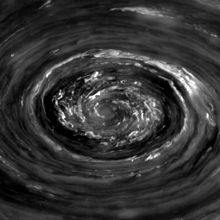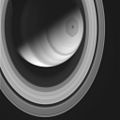Saturn's hexagon



Saturn's hexagon is a persisting hexagonal cloud pattern around the north pole of Saturn, located at about 78°N.[1][2][3] The sides of the hexagon are about 13,800 km (8,600 mi) long, which is more than the diameter of Earth[4] (about 12,700 km (7,900 mi)). It rotates with a period of 10h 39m 24s, the same period as Saturn's radio emissions from its interior.[5] The hexagon does not shift in longitude like other clouds in the visible atmosphere.[6]
Saturn's south pole does not have a hexagon, according to Hubble observations; however, it does have a vortex, and there is also a vortex inside the northern hexagon.[7]
Saturn's polar hexagon discovery was made by the Voyager mission in 1981–82,[8] and it was revisited since 2006 by the Cassini mission.[9] Cassini was only able to take thermal infrared images of the hexagon, until it passed into sunlight in January 2009.[10] Cassini was also able to take a video of the hexagonal weather pattern while traveling at the same speed as the planet, therefore recording only the movement of the hexagon.[11] After its discovery, and after it came back into the sunlight, amateur astronomers managed to get images showing the hexagon from Earth.[12]
Explanations for hexagon shape
One hypothesis, developed at Oxford University, is that the hexagon forms where there is a steep latitudinal gradient in the speed of the atmospheric winds in Saturn's atmosphere.[13] Similar regular shapes were created in the laboratory when a circular tank of liquid was rotated at different speeds at its centre and periphery. The most common shape was six sided, but shapes from three to eight sided were also produced. The shapes form in an area of turbulent flow between the two different rotating fluid bodies with dissimilar speeds.[13][14] A number of stable vortices of similar size form on the slower (south) side of the fluid boundary and these interact with each other to space themselves out evenly around the perimeter. The presence of the vortices influences the boundary to move northward where each is present and this gives rise to the polygon effect.[14] Polygons do not form at wind boundaries unless the speed differential and viscosity parameters are within certain margins and so are not present at other likely places, such as Saturn's south pole or the poles of Jupiter.
Other researchers claim that lab studies exhibit vortex streets, a series of spiraling vortices not observed in Saturn's hexagon. Simulations show that a shallow, slow, localized meandering jetstream in the same direction as Saturn's prevailing clouds is able to match the observed behaviors of Saturn's Hexagon with the same boundary stability.[15]
The hexagonal shape may be the result of a sextupole magnetic field component of the planet and possibly correlated with radio emission anomalies.
North polar vortex
There is a vortex inside the northern hexagon.[7]


Color change
Between 2012 and 2016, the hexagon changed from a mostly blue color to more of a golden color.[16] One theory for this is that sunlight is creating haze as the pole is exposed to sunlight due to the change in season.[16] These changes were observed by the Cassini-Huygens orbiter.[16]
Gallery
-
Cassini imaged this on March 22, 2014 (MT2 and CL2 filters)
-
True color imaging (2013)
-
Saturn's north pole , true color (2013)[18]
-
View from about 630,000 kilometres (390,000 mi) away at 938 nm (near-IR)
-
Infrared view
Popular usage
The English musician Paul Weller released the album Saturns Pattern in 2015.
See also
References
- ^ Godfrey, D. A. (1988). "A hexagonal feature around Saturn's North Pole". Icarus. 76 (2): 335. Bibcode:1988Icar...76..335G. doi:10.1016/0019-1035(88)90075-9.
- ^ Sánchez-Lavega, A.; Lecacheux, J.; Colas, F.; Laques, P. (April 16, 1993). "Ground-based observations of Saturn's north polar SPOT and hexagon". Science. 260 (5106). American Association for the Advancement of Science: 329–32. Bibcode:1993Sci...260..329S. doi:10.1126/science.260.5106.329. PMID 17838249.
- ^ Overbye, Dennis (August 6, 2014). "Storm Chasing on Saturn". New York Times. Retrieved August 6, 2014.
- ^ "New images show Saturn's weird hexagon cloud". MSNBC. December 12, 2009. Archived from the original on 2011-10-05. Retrieved 2013-12-05.
{{cite news}}: Unknown parameter|deadurl=ignored (|url-status=suggested) (help) - ^ Godfrey, D. A. (March 9, 1990). "The Rotation Period of Saturn's Polar Hexagon". Science. 247 (4947): 1206–1208. Bibcode:1990Sci...247.1206G. doi:10.1126/science.247.4947.1206. PMID 17809277.
- ^ Baines, Kevin H.; et al. (December 2009). "Saturn's north polar cyclone and hexagon at depth revealed by Cassini/VIMS". Planetary and Space Science. 57 (14–15): 1671–1681. Bibcode:2009P&SS...57.1671B. doi:10.1016/j.pss.2009.06.026.
- ^ a b Sánchez-Lavega, A.; Pérez-Hoyos, S.; French, R. G. (October 8, 2002). "Hubble Space Telescope Observations of the Atmospheric Dynamics in Saturn's South Pole from 1997 to 2002". American Astronomical Society. 34. American Astronomical Society: 13.07. Bibcode:2002DPS....34.1307S. Archived from the original on September 5, 2008. Retrieved 2013-12-05.
- ^ Caldwell, John; Benoit, Turgeon; Hua, Xin-Min; Barnet, Christopher D.; Westphal, James A. (April 16, 1993). "The Drift of Saturn's North Polar Spot Observed by the Hubble Space Telescope". Science. 260 (5106). AAAS: 326–329. Bibcode:1993Sci...260..326C. doi:10.1126/science.260.5106.326. ISSN 0036-8075. PMID 17838248. Retrieved 2013-12-05.
- ^ "Saturn's Strange Hexagon". NASA. March 27, 2007. Retrieved 2013-05-01.
- ^ "Saturn's Mysterious Hexagon Emerges From Winter Darkness". NASA. December 9, 2009. Retrieved 2013-05-01.
- ^ "NASA's Cassini Spacecraft Obtains Best Views of Saturn Hexagon". Jet Propulsion Laboratory (NASA). December 4, 2013. Retrieved 2013-12-05.
- ^ Fletcher, Leigh. "Saturn's Hexagon Viewed from the Ground". The Planetary Society.
- ^ a b Barbosa Aguiar, Ana C.; Read, Peter L.; Wordsworth, Robin D.; Salter, Tara; Yamazaki, Y. Hiro (April 2010). "A laboratory model of Saturn's North Polar Hexagon". Icarus. 206 (2): 755–763. Bibcode:2010Icar..206..755B. doi:10.1016/j.icarus.2009.10.022.
- ^ a b Lakdawalla, Emily (4 May 2010). "Saturn's hexagon recreated in the laboratory". Planetary.org. Retrieved 2014-02-07.
- ^ Morales-Juberías, R.; Sayanagi, K.M.; Simon, A.A.; Fletcher, L.N.; Cosentino, R.G. (10 June 2015). "Meandering Shallow Atmospheric Jet as a Model of Saturn's North-Polar Hexagon". The Astrophysical Journal Letters. doi:10.1088/2041-8205/806/1/L18.
- ^ a b c [1]
- ^ [File:PIA21049saturnhex1216.jpg]
- ^ NASA
External links
- Cassini Video of Saturn's Hexagon on YouTube
- Saturn Revolution 175, Cassini images, November 27, 2012
- Saturn’s Strange Hexagon – In Living Color! - Universe Today
- Edge of the hexagon from Planetary Photojournal
- Saturn's Hexagon Comes to Light, APOD January 22, 2012
- In the Center of Saturn's North Polar Vortex, Astronomy Picture of the Day - December 4, 2012
- Video of hexagon's rotation from NASA
- NASA's Cassini Spacecraft Obtains Best Views of Saturn Hexagon (December 4, 2013)
- Animated vortex view (TPS)
- http://www.ciclops.org////view_media.php?id=38331
- Saturn's Hexagon Replicated In Laboratory, video
- Hexagon Changes Color (October 21, 2016)



![Saturn's north pole , true color (2013)[18]](http://upload.wikimedia.org/wikipedia/commons/thumb/b/b3/Saturn_North_Pole_2013-07-22.jpg/120px-Saturn_North_Pole_2013-07-22.jpg)




